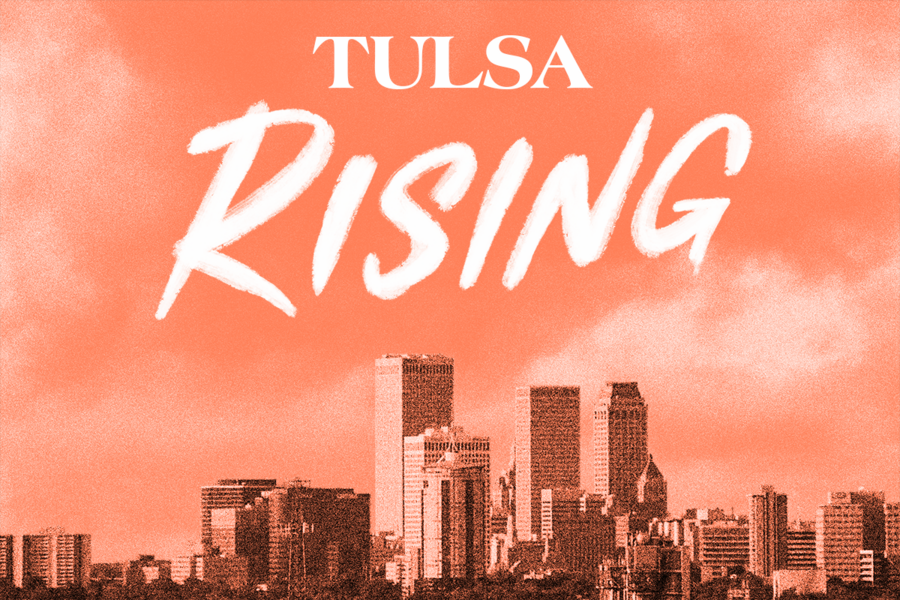Loading...
Wrestling with history: One city’s 100-year struggle to heal
Tulsa, Oklahoma, is commemorating the centennial of one of the worst incidents of racist violence in U.S. history. In our podcast “Tulsa Rising,” we ask: How does a city reckon with its racist past?
In the summer of 1921 in Tulsa, Oklahoma, a young Black man named Dick Rowland was accused of assaulting Sarah Page, a white elevator operator. As the story spread, angry white residents came together to take matters into their own hands. On May 31, these residents attacked the thriving Black neighborhood of Greenwood, looting, burning, and killing.
The event is now known as the 1921 Tulsa race massacre, and it is one of the worst incidents of racist violence in U.S. history.
But the massacre is just the beginning of the story. Over the next 100 years, Tulsa’s Black community would rebuild again and again – in the aftermath of the massacre, and in the face of everything from Jim Crow laws and segregation to police violence and systemic racism.
Now, at the massacre’s centennial, the city is starting to come to terms with its painful history. Our new podcast, “Tulsa Rising,” explores that process – of ruination, resentment, and reparation – through the eyes of Tulsa residents. We ask: What does it look like to reckon with racism? And is reconciliation possible?
Episode transcript
[Music]
Jessica Mendoza: In the summer of 1921, in the city of Tulsa, Oklahoma, a young Black man was accused of assaulting a white woman.
Scott Ellsworth: ...published this front page article about how Roland had stalked this young elevator operator and clearly tried to rape her. There’s lynch talk within a half an hour.
Samantha Laine Perfas: White residents formed a mob.
Jess: And for 24 hours on May 31st and June 1st, this mob burned, looted, and killed throughout the Black neighborhood of Greenwood.
Sam: Some Black residents fought back, but –
Scott: … when the state troops from Oklahoma City finally arrived to restore order, Greenwood’s been destroyed. It’s been burnt to the ground. Greenwood is gone.
Sam: That event is now known as the 1921 Tulsa Race Massacre –
Jess: – and it’s one of the worst incidents of racist violence in U.S. history.
[Music]
Sam: But the story doesn’t end there. Over the next hundred years, the Black community in Tulsa rose up over and over and over –
Jess: – in the face of segregation and Jim Crow –
Sam: – in support of civil rights and the Black vote –
Jess: – and against police violence and systemic racism.
Sam: Now, at the centennial of the massacre, Tulsa is rising up again.
[Music]
Jess: From The Christian Science Monitor, I’m Jessica Mendoza.
Sam: And I’m Samantha Laine Perfas.
Jess: This is “Tulsa Rising.”
Sam: The story of a city wrestling with its racist past and – maybe – forging a better future. We take you on the ground to Tulsa, and hear from pastors –
Robert Turner: Their blood still speaks. Their blood is still crying out.
Jess: And politicians –
G.T. Bynum: ‘Surely we would have heard about it if there were mass graves.’
Sam: Activists –
Tiffany Crutcher: They ask, ‘What would money do?’ It’s just not about money.
Jess: And artists –
Jerica Wortham:
For that
Greenwood ave
That Redman land
That Brilliance build by black man hand, legacies...
Sam: Through them, we’ll come to understand the pain and the power of confronting racism head-on.
Jess: Because we can only really move forward if we’re prepared to look back.
Turner: We need to digest on what we did to a group of people solely because they were Black. I’m all for moving forward, working together. But let’s understand where we come from.
[Music]
Sam: Listen to “Tulsa Rising” for free wherever you get your podcasts, or visit csmonitor.com/tulsarising. All episodes will be available on May 28th. Again, you can find everything at csmonitor.com/tulsarising.
[Music]
Jess: This podcast was produced by The Christian Science Monitor, copyright 2021.
[END]




